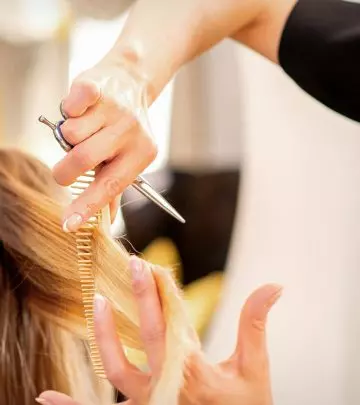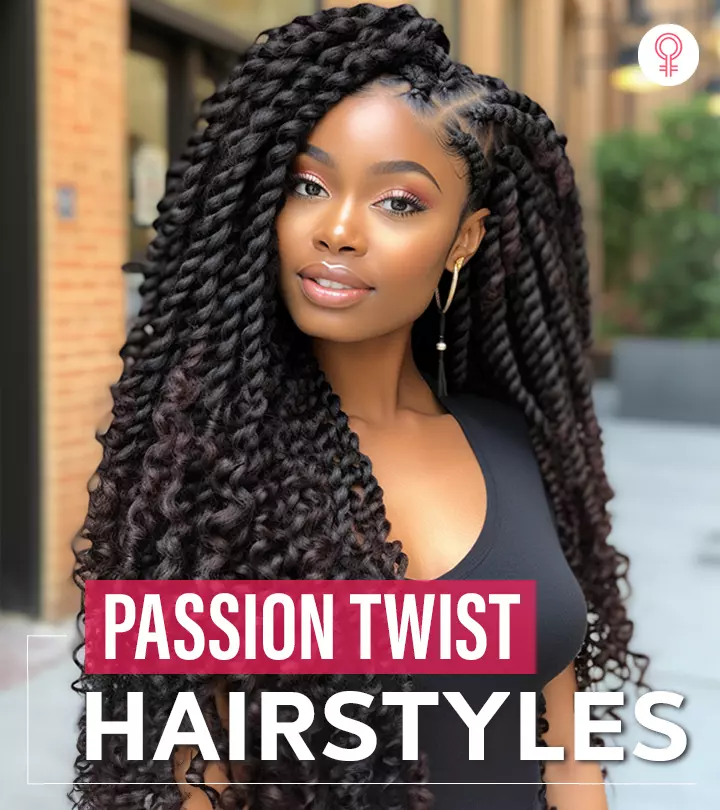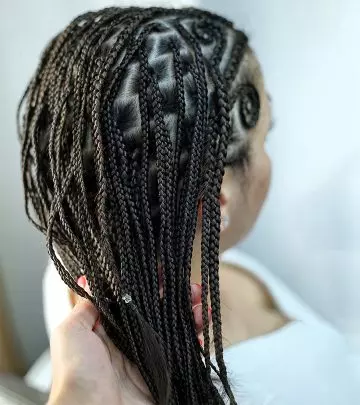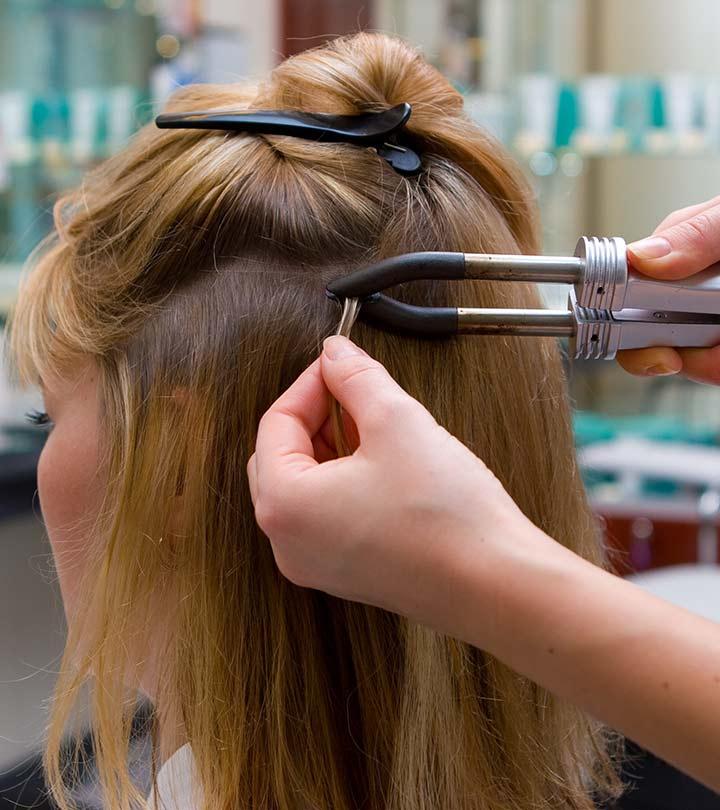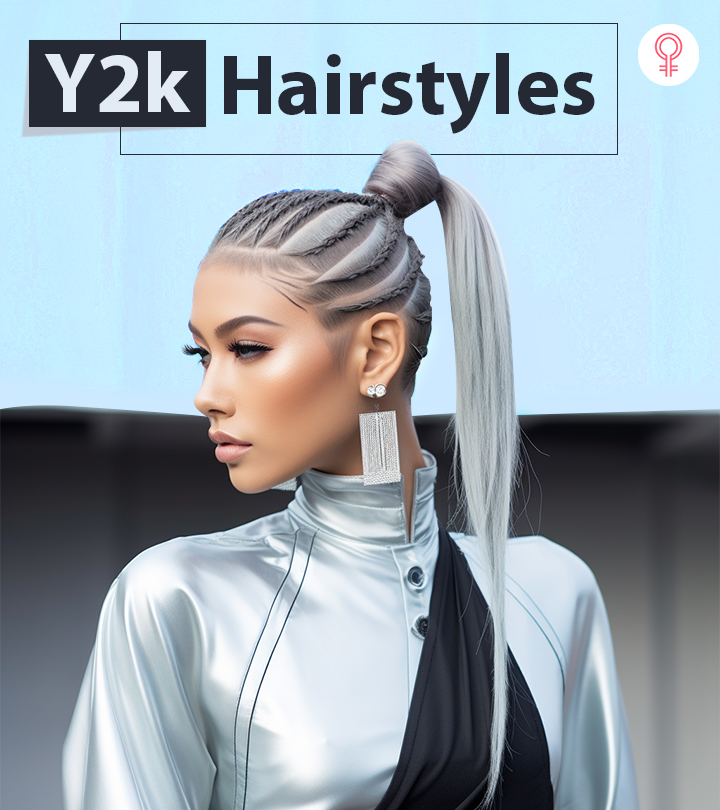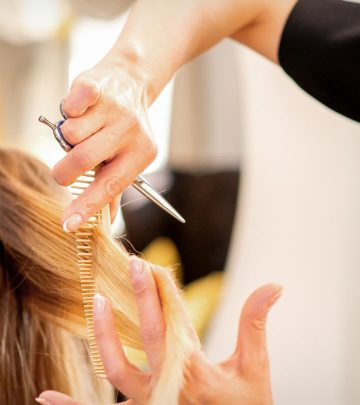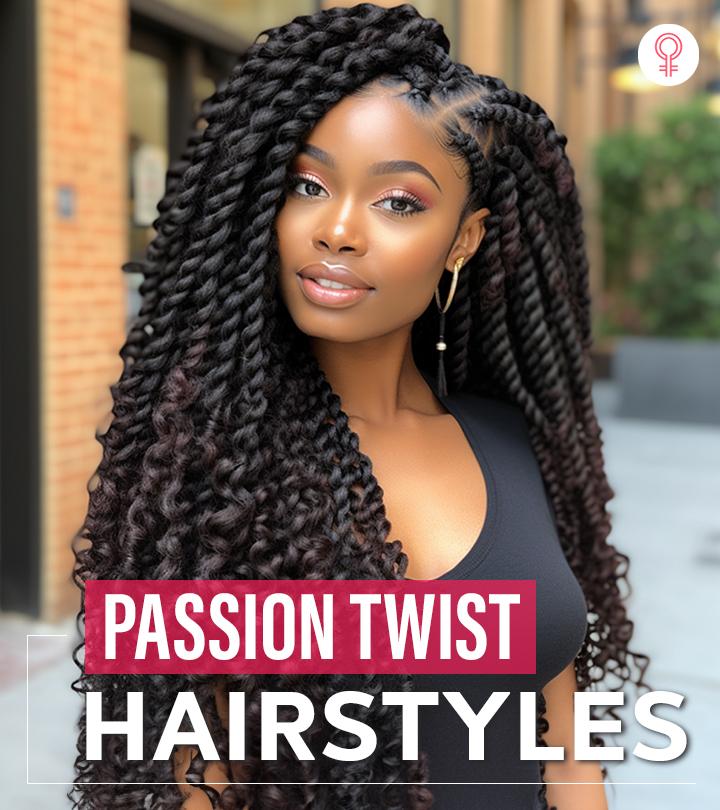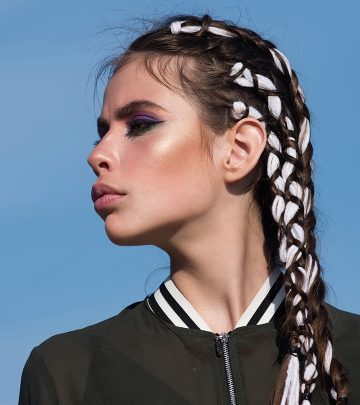What Are Sisterlocks? Installation, Cost, Upkeep, And More
Say goodbye to hair hassles and embrace the beauty and versatility of protective hairstyles.

Image: Shutterstock
From box braids to Marley twists, there is no denying that there are plenty of gorgeous hairstyles for natural hair. But if you are looking for something that offers a captivating fusion of culture, versatility, and self-expression, you need to check out Sisterlocks. This stunning hairstyle that has recently been doing the rounds all over social media is all about tiny, uniform locs installed using an interlocking method. The look provides a lot of freedom to experiment with various styling options and hair colors with minimal damage. Pretty cool, right? And once they mature after installation, these locs are fairly low-maintenance. If you wish to know more about this protective style, follow us along as we give you a complete rundown of Sisterlocks, including their pros and cons, installation process, care tips, and more. Read on!
 Before You Get Started
Before You Get Started- Healthy and damage-free scalp and hair are prerequisites to getting Sisterlocks, as they provide the ideal foundation for the hairstyle.
- Your hair should be at least 3 to 4 inches in length for the Sisterlocks installation. If it is shorter than this, you may need to wait until it grows out a bit more.
- Achieving the look requires time and commitment. Depending on the length and thickness of your hair, installation may take several hours to a full day or more.
In This Article
A Brief History Of Sisterlocks
Dr. JoAnne Cornwell, a California-based woman, created and trademarked Sisterlocks in 1993. She developed the technique as a way to provide Black women, who were interested in self-empowerment and cultural self-expression with a low-maintenance yet versatile natural hair option that is not just beautiful but also self-affirming. On her official website, Dr. Cornwell mentions how the company motto of “Sisterlocks is not about a hairstyle, it’s about a lifestyle,” forms the bedrock of her beliefs that led her to move forward with this protective hairstyle (1). Now, over 30 years later, the famous Sisterlocks hairstyle is loved by Black women worldwide.
 Trivia
TriviaSisterlocks, like regular locs, promote the idea of self-acceptance and celebrate the unique beauty of African American hair in its natural state. However, both of these natural hairstyles have several key differences. The following section will give you a quick overview of them.
Differences Between Sisterlocks And Regular Locs
Sisterlocks are small, tightly woven locs, typically created on natural hair. This natural style is created by meticulously sectioning the hair into small, evenly-sized locks using a dedicated tool. Unlike regular locs or dreadlocks that are characterized by matted, ropelike strands, Sisterlocks are typically smaller in size, resulting in a sleeker and more refined appearance. Below are some key differences between the two:
| Sisterlocks are much smaller, thinner and more uniform in size. | Regular locs are usually thicker and chunky, varying in size. |
| They are created using the interlocking method and a patented specialized tool. | Regular locks use techniques like palm-rolling, two-strand twisting, braiding, and comb-coiling. |
| The Sisterlocks installation process may take as long as 36 hours. | Regular locs usually take between 2 to 3 hours to install. |
| Sisterlocks are performed by certified Sisterlocks consultants and require greater precision. | Regular locs involve less precision and can be done at home or by a professional stylist. |
| With Sisterlocks, you may need to test-install a few locs to figure out which pattern is ideal for your hair type. | You need no installation test for regular locs and can go ahead without much preparation. |
Despite these differences, both Sisterlocks and regular locs require proper maintenance for them to be healthy. Also, both of them offer styling versatility. However, the options may be more limited for regular locs due to their larger size and irregular shape.
Both Sisterlocks and traditional locs offer unique looks, and the choice between the two depends on your personal preferences. If you decide to go ahead with Sisterlocks, it is important to know both the good and not-so-great aspects of this style. Keep scrolling to be informed.
Pros And Cons Of Sisterlocks
When deciding if Sisterlocks are a good choice for you, it helps to have a list of their pros and cons. We have made it easier for you by listing them below:
Pros
- Sisterlocks are versatile and can help you change your look with ease. They can be styled in various ways, including updos, braids, twists, and curls.
- They are smaller, more uniform, and lighter, making them more comfortable to wear, especially for those with fine or delicate hair.
- They promote healthy hair growth, as they do not require a lot of heavy hair products or frequent manipulation. This allows the scalp to breathe, reduces tension on it, and minimizes product buildup.
- Apart from the routine re-tightening every few weeks for the first year, they are pretty low maintenance as compared to other locs styles.
- They can be customized to your specific hair texture to resemble it closely, thereby offering a more organic look.
- If properly maintained, they can last for several years, making them an excellent option for those who prefer a semi-permanent hairstyle.
Another advantage of Sisterlocks is that they will make your hair-washing process much simpler. Sonya, a blogger, shared her experience of washing her natural hair after getting the locks. She writes, “I felt no stress, no dread, no tired arms like I did when I was a loose natural! I was able to go about my business around the house as my hair dried on its own.” She also emphasized the freedom from agonizing over preparing her hair after getting the locs, noting, “This newfound hair freedom is glorious. That’s the best way I can describe it. Once my hair was completely dry, I plaited it up, tied it up and went to bed. The next morning I took my plaits down, fluffed my hair and went to work. You guys – the fact that I can get up in the morning and not worry about how I’m going to wear my hair or what steps I’m going to need to take to achieve a look is EVERYTHING (i)!”
Cons
- As this is a patented style, you need to find a Sisterlocks consultant to install it. If you cannot find one in your area, you may have to travel to the location where they are available.
- The initial installation of Sisterlocks can be expensive, as it is a professional service. Further, the initial consultation and maintenance costs might add up over time.
- The installation process is long and may take several hours or even days, depending on the length and density of your hair. The maintenance appointments may be time-consuming as well.
- Though Sisterlocks offer styling versatility in the long run, this may not be the case during the early stages, as they need time to mature and settle.
Sonya also shared her experience of getting the locs and the first week which was extremely frustrating for her. She writes, “I didn’t wash my hair the first week, and after experimenting with styling my hair and becoming increasingly frustrated because my hair only went one way, I washed my hair the beginning of the second week. Now my hair feels much better. The shrinkage is real, but that’s ok.”
Though Sisterlocks have some cons, their pros definitely outweigh them. However, to get your desired outcome from this style, it is important to find out if they are suitable for your specific hair. The following section talks about the right hair types that can opt for this protective style. Check it out!
What Is The Right Hair Type For Sisterlocks?
Sisterlocks are usually best suited for those with naturally curly and coiled hair textures. While they can be installed on various hair textures, they are best suited for type 4 hair, as they tend to hold the locks better due to their natural texture and coil pattern. These may include 4A, 4B, and 4C hair textures. Here is a brief breakdown of them:
- Type 4A hair consists of tight, defined curls with a visible S-shaped pattern. It is relatively soft and has a fine texture.
- Type 4B hair consists of a less defined curl pattern and appears as tight, densely packed coils. It tends to be more wiry and has a cotton-like texture.
- Type 4C hair consists of tightly coiled strands that form intricate zig-zag or z-shaped patterns. It is fragile and prone to shrinkage.
Further, when it comes to hair density and thickness, the locs can be installed on a variety of them, including thick, fine, and thin hair. You may also get this look on hair that is relaxed and of varying lengths.
 Trivia
TriviaIdeally, it is recommended to consult a certified consultant or stylist before getting Sisterlocks installed, as they can assess your hair type and provide personalized recommendations. Along with this, the following section elaborates on some prep you need to take care of before the installation process.
How To Prepare For Installing Sisterlocks
Before going for Sisterlocks, it is important to do thorough research and understand everything about the style. This will help you decide whether the style aligns with your personal style and lifestyle. Along with this, here is a checklist of a few things you may keep in mind:
- Since the Sisterlocks technique is one-of-a-kind and is patented by a company, it requires consultants who have undergone training and certification to do it. You may look for one on their official website, and depending on your location, schedule a consultation.
- During the meeting with the consultant, discuss your desired style, the size of locks you prefer, or any other queries you have about the style. It is also a good idea to check the consultant’s social media page or website for a glimpse into their previous work.
- Once your appointment is set up, consider deep conditioning treatments to hydrate and strengthen your hair and improve its overall health.
- Avoid using any chemical treatments such as relaxers or perms, as they weaken the hair and make it more susceptible to damage.
- If your consultant recommends a trim, get it done to ensure your hair ends are even, healthy, and free of split-ends.
- A few days before the appointment, use a clarifying shampoo to ensure your hair is clean and free of residue.
- It is also a good idea to detangle your hair thoroughly before the installation. This will help prevent unnecessary breakage and make the process smoother.
Sisterlocks require commitment and quite a bit of patience, as they take time to install, settle, and mature. Check out the next section to get an idea about what the process involves so that you can mentally prepare yourself for the journey ahead.
Step-By-Step Process Of Sisterlocks Installation
The installation phase of Sisterlocks may take nearly 15-24 hours, depending on your hair length, density, and head size. Due to this, your consultant may also sometimes break down this process across multiple sessions. Here are some of the key steps:
1. Preparation: Before installation begins, the consultant will thoroughly wash and condition your hair to ensure it is clean and free of any product buildup.
2. Hair Sectioning And Parting: The consultant will then divide your hair into small uniform sections, followed by parting the sections into rows. While all Sisterlocks consultants are trained to be systematic in the way they do this, each of them may have their unique variation. The size and number of these sections and parts will depend on your hair density, texture, and desired look.
3. Locking: This is the final step of the installation process during which the consultant will use a patented locking tool to twist and interlock small sections of your hair from root to tip. They will work systematically through each section and row to create a tight, uniform pattern.
Once you are done with the installation process, your newly formed locks will take some time to mature. This process can take several months to years, and it occurs in different stages that are discussed in the following section. Keep reading!
Stages Of Maturation Of Sisterlocks
Once you get your Sisterlocks installed, they generally go through four stages to mature completely. These include the pre-locking, budding, shooting, and contracting stages. Here is everything you need to know about them:
1. Pre-Locking Stage: At this stage, your Sisterlocks are freshly installed and will appear small, tightly coiled, and have neat parting lines. Since it is just the starting stage, your locs will be quite fragile, making it necessary for you to be extra careful while washing them; this will ensure they do not unravel. The stage is also known as the newbie, baby lock, or starter Sisterlocks stage.
2. Budding Stage: During this stage, your hair will start to lock properly, and you will notice the formation of small buds of hair at the shaft and ends of your strands. Your locs will also begin to thicken, swell, and become more secure, eliminating the risk of them unraveling. This stage is also known as the teenage stage.
3. Shooting Stage: At this stage, you will experience the interlocking process intensifying and your locs growing longer and more noticeable. The buds that formed during the teenage stage will lay the foundation for further progress, and your hair will begin matting from the shaft to the tips and back. This stage is also known as the adult stage, and you may notice some new hair growth during it.
4. Contracting Stage: This is the final stage of the Sisterlocks process, during which your locks will mature. You will notice that they are now sealed, secured, and uniform in length. This stage is also known as the elder locks stage.
If you wish to ensure your Sisterlocks remain healthy during these stages, and even beyond them, taking proper care is important. Scroll down for some quick tips to keep them looking beautiful and managed.
How To Provide Long-Term Care For Sisterlocks
The long-term care of Sisterlocks involves a combination of proper cleansing, moisturizing, protecting, and regular maintenance of the hair. Doing so will ensure that they last for years to come. Here is what you may do for the daily upkeep of your Sisterlocks:
- Use a gentle shampoo to cleanse the scalp and locks. Avoid excessive scrubbing, as this can cause frizz and damage the Sisterlocks.
- Minimize the use of heat styling tools, as they can weaken and damage the hair over time (2). Instead, opt for no-heat styling options, such as sock curls.
- Use a lightweight oil to hydrate both the scalp and the length of the locks. This will keep them moisturized and prevent dryness and breakage.
- Opt for regular trims to remove any damaged or split ends and maintain the overall health of your Sisterlocks.
- Avoid styling your locs in hairdos such as tight ponytails or braids as they can cause tension, thinning, and breakage (3).
- If you choose to color your locks, know that this may come with side effects like dryness and irritation (4). Take extra care of your hair by opting for weekly deep conditioning sessions or opt for natural hair coloring options like henna.
- Cover your Sisterlocks with a silk or satin scarf, or use a silk or satin pillowcase to minimize friction and prevent breakage while sleeping.
Along with all these tips, it is also recommended to book timely follow-up appointments for your Sisterlocks until they are completely settled in. This is because, as your hair grows, the locks require periodic retightening to maintain their appearance. Depending on your rate of hair growth, your installer may schedule these sessions every 4 to 8 weeks.
With a little effort, you can maintain your Sisterlocks for a long time, over many years. However, this trendy hairstyle is not cheap. Find out below how much you may have to shell out for this look.
How Much Do Sisterlocks Cost?
Generally, the consultation and the initial Sisterlocks installation may cost you around $400-$1000, and even more. The actual cost may vary depending on various factors, such as the location, the experience and skill levels of your consultant, and the length and thickness of your hair. However, the cost of maintenance is another factor you need to consider. These follow-up sessions may cost anywhere between $100-$250, and you may need to take nearly six of them for the first year. This means that along with getting the process done, you will also have to spend around $600-$1500 on mandatory upkeep. It is recommended to consult a certified Sisterlocks stylist to get an accurate estimate of the total Sisterlocks cost before booking an appointment.
Sisterlocks, microlocs, and dreadlocks are all popular methods of styling and maintaining natural hair. If you are confused about which of the three is best for you, the following section offers you a comparative study. Check it out to make an informed decision.
Sisterlocks Vs. Microlocs Vs. Dreadlocks
Sisterlocks and microlocs offer a more controlled and refined look, making them perfect for those who want a more uniform look. Dreadlocks, on the other hand, provide a more natural and freeform style. Ultimately, the choice between them depends on your personal preference and desired aesthetic. The following table compares different aspects of these popular protective hairstyles to help you choose.
| Aspects | Sisterlocks | Microlocs | Dreadlocks |
|---|---|---|---|
| What Is It? | A trademarked hairstyle and brand. | A generic term used to describe various locs styles that are smaller in size. | A common hairstyle made of rope-like strands of hair. |
| Installation | Requires a certified and trained consultant. | Can be done either by a hairstylist or at home. | Can be done either by a hairstylist or at home. |
| Precision | Requires a precise grid pattern and a special tool. | Can be started with or without a grid pattern. | Requires no particular pattern. |
| Time Taken | Quite time-consuming. | Fairly time-consuming. | Quick to achieve. |
| Appearance | Appears neat and uniform. | Appears neat, uniform, and a bit more textured. | Appears thicker and quite textured. |
| Versatility | Offers versatile styling options. | Offers versatile styling options. | Offers limited styling options. |
| Maintenance | Low-maintenance, but the initial months require a fair amount of upkeep. | Low-maintenance, but requires some upkeep. | Light-maintenance, but requires some upkeep. |
While all these hairstyles differ from each other to some extent, the one thing common about them is that they are all pretty low-maintenance. Of course, you will have put in some effort to ensure their health and overall appearance. But apart from that, they require as much care and maintenance as any other protective hairstyle.
The Sisterlocks hairstyle offers a unique option for Black women seeking the confidence to wear their hair naturally and stylishly while protecting it. While their installation process is time-consuming, and the initial costs may add up, their long-term benefits and reduced upkeep expenses after maturation make them a worthwhile investment. With proper care and maintenance, this stunning look can last for years, even a lifetime, making it a convenient and practical styling option. Whether you are looking for a hairstyle to embrace the beauty of your natural hair texture or seeking an aesthetically appealing look, Sisterlocks are worth a try!
Frequently Asked Questions
Can Sisterlocks be reversed?
Yes, just like all other natural, protective styles, Sisterlocks can be reversed. However, this can happen only during the initial phase of the look, which is the first six months after installation. Beyond it, the locks become pretty permanent and are tedious to undo. At this stage, you may have to cut your Sisterlocks and let your natural hair grow. Therefore, before getting Sisterlocks done, it is important to decide if they are the right hairstyle for you.
Will Sisterlocks break my hair or cause them to thin out?
No, when installed by an expert and maintained properly, Sisterlocks should not break your hair or cause it to thin out. In fact, the style is designed to promote healthy hair growth by reducing tension on the scalp and minimizing manipulation. However, anecdotal evidence suggests that Sisterlocks retightened with dry hair may make your hair more prone to breakage and cause thinning at the roots.
Can I wash my Sisterlocks?
Yes, you may wash your Sisterlocks every 1 to 2 weeks with a gentle, residue-free shampoo. Avoid excessive scrubbing or manipulation during the wash to maintain the integrity of your locks. Also, ensure thorough rinsing and gentle drying to prevent frizz and breakage.
Key Pointers
- Sisterlocks are best suited for type 4 hair, particularly 4A, 4B, and 4C textures.
- Their installation process involves sectioning, parting, and locking small sections of hair using a meticulous interlocking method and may typically take between 15 to 24 hours or more.
- They offer versatility, promote healthy hair growth, and can last for several years with proper care.
- However, they require a certified consultant for installation and are initially expensive.
- Their proper maintenance involves gentle cleansing, moisturizing, protection from tension and heat, and periodic retightening appointments.
Sisterlocks is a low-maintenance, versatile natural hair option that can last for years with proper care. If you are thinking about getting the look, this video talks about everything you should know before getting it. Check it out!vers
Personal Experience: Source
StyleCraze's articles are interwoven with authentic personal narratives that provide depth and resonance to our content. Below are the sources of the personal accounts referenced in this article.
(i) Sisterlocks: two weeks in & first wash!https://2dimplzs.wordpress.com/2018/11/29/Sisterlocks-two-weeks-in-first-wash/comment-page-1/
References
Articles on StyleCraze are backed by verified information from peer-reviewed and academic research papers, reputed organizations, research institutions, and medical associations to ensure accuracy and relevance. Read our editorial policy to learn more.
- The Sisterlocks business
https://www.Sisterlocks.com/about-us.html - On hair care physicochemistry: from structure and degradation to novel biobased conditioning agents
https://www.ncbi.nlm.nih.gov/pmc/articles/PMC9921463/ - Treatment-refractory central centrifugal cicatricial alopecia responsive to a novel botanical treatment
https://www.ncbi.nlm.nih.gov/pmc/articles/PMC9004676/ - Local side effects caused by hair dye use in females: Cross-sectional survey
https://pubmed.ncbi.nlm.nih.gov/22417994/
Read full bio of Madhumati Chowdhury
Read full bio of Vaishali Sinha












